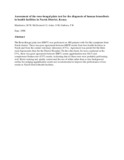| dc.contributor.author | Maichomo, M W | |
| dc.contributor.author | McDermott J J | |
| dc.contributor.author | Arimi, S M | |
| dc.contributor.author | Gathura, P B | |
| dc.date.accessioned | 2013-03-15T09:28:10Z | |
| dc.date.issued | 1998 | |
| dc.identifier.citation | East African Medical Journal Vol. 75 No.4 April 1998 | en |
| dc.identifier.uri | http://erepository.uonbi.ac.ke:8080/xmlui/handle/123456789/14042 | |
| dc.description.abstract | The Rose-Bengal plate test (RBPT) was performed on 488 patients with flu-like symptoms from Narok district. There was poor agreement between RBPT results from four health facilities in Narok and from the central veterinary laboratory (CVL). Agreement was poorer for the three rural dispensaries than for the District Hospital. On the other hand, for tests conducted at the CVL, there was good agreement between RBPT, serum agglutination test (SAT) and complement fixation test (CFT) results, indicating that all these tests were probably performing well. Better training and quality control and the use of white rather than a clear background surface for judging agglutination results are recommended to improve the performance of test results in Narok District health facilities. | en |
| dc.language.iso | en | en |
| dc.subject | Human brucellosis | en |
| dc.subject | Health facilities | en |
| dc.title | Assessment of the rose-bengal plate test for the diagnosis of human brucellosis in health facilities in Narok District, Kenya | en |
| dc.type | Article | en |
| local.publisher | Department of Public Health, Pharmacology and Toxicology | en |

